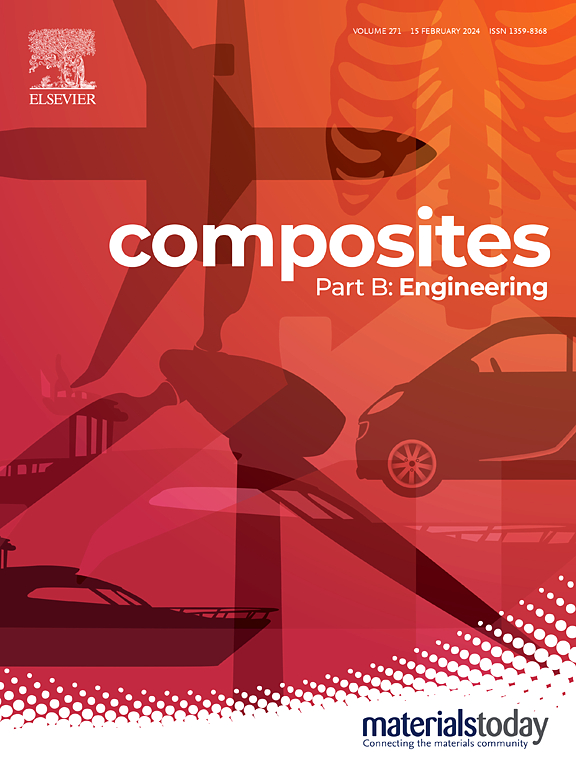Flame-retardant, thermally conductive, and mechanically strong epoxy composites with phenylphosphonic acid-functionalized boron nitride nanosheets
IF 12.7
1区 材料科学
Q1 ENGINEERING, MULTIDISCIPLINARY
引用次数: 0
Abstract
Epoxy resin (EP)-based thermally conductive composites have become strong candidate materials for heat dissipation of electronic devices. However, the inherent low thermal conductivity (TC) and combustible nature of traditional EPs have markedly limited their application. In this work, we developed an EP-composite containing phenylphosphonic acid (PPA)-functionalized boron nitride nanosheets (BNNS), i.e., PPA@BNNS, via ball milling exfoliation of hexagonal boron nitride with PPA, which served as an interfacial modifier and a flame retardant. The PPA attached on the BNNS surface through π-π interactions enhanced the interfacial compatibility between filler and EP, minimized BNNS agglomeration, and improved the mechanical strength of EP/PPA@BNNS composite. In particular, the EP/PPA@BNNS composite with 30 wt% filler exhibited a 4.5-fold increase in TC relative to neat EP, manifesting the well-connected thermal conductive pathways formed by the uniformly dispersed PPA@BNNS and the reduced interfacial thermal resistance. Moreover, the EP/PPA@BNNS composite with 5 wt% filler displayed superior flame retardancy; the peak heat release rate and total heat release were reduced to half those of neat EP owing to the physical barrier action and catalytic carbonization effect of PPA@BNNS.
苯基膦酸功能化氮化硼纳米片阻燃、导热、机械强度强的环氧复合材料
环氧树脂(EP)基导热复合材料已成为电子器件散热的有力候选材料。然而,传统EPs固有的低导热性和可燃性明显限制了其应用。在这项工作中,我们开发了一种含有苯基膦酸(PPA)功能化氮化硼纳米片(BNNS)的ep复合材料,即PPA@BNNS,通过球磨六方氮化硼与PPA,作为界面改性剂和阻燃剂。PPA通过π-π相互作用附着在BNNS表面,增强了填料与EP之间的界面相容性,减少了BNNS团聚,提高了EP/PPA@BNNS复合材料的机械强度。特别是,与纯EP相比,添加30% wt%填料的EP/PPA@BNNS复合材料的TC增加了4.5倍,这表明均匀分散的PPA@BNNS形成了连接良好的导热通道,并降低了界面热阻。此外,添加5 wt%填料的EP/PPA@BNNS复合材料表现出优异的阻燃性;由于PPA@BNNS的物理屏障作用和催化碳化作用,峰值放热率和总放热率降至纯EP的一半。
本文章由计算机程序翻译,如有差异,请以英文原文为准。
求助全文
约1分钟内获得全文
求助全文
来源期刊

Composites Part B: Engineering
工程技术-材料科学:复合
CiteScore
24.40
自引率
11.50%
发文量
784
审稿时长
21 days
期刊介绍:
Composites Part B: Engineering is a journal that publishes impactful research of high quality on composite materials. This research is supported by fundamental mechanics and materials science and engineering approaches. The targeted research can cover a wide range of length scales, ranging from nano to micro and meso, and even to the full product and structure level. The journal specifically focuses on engineering applications that involve high performance composites. These applications can range from low volume and high cost to high volume and low cost composite development.
The main goal of the journal is to provide a platform for the prompt publication of original and high quality research. The emphasis is on design, development, modeling, validation, and manufacturing of engineering details and concepts. The journal welcomes both basic research papers and proposals for review articles. Authors are encouraged to address challenges across various application areas. These areas include, but are not limited to, aerospace, automotive, and other surface transportation. The journal also covers energy-related applications, with a focus on renewable energy. Other application areas include infrastructure, off-shore and maritime projects, health care technology, and recreational products.
 求助内容:
求助内容: 应助结果提醒方式:
应助结果提醒方式:


